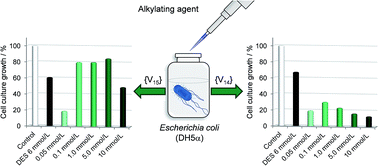Chemoprotective activity of mixed valence polyoxovanadates against diethylsulphate in E. coli cultures: insights from solution speciation studies†
Abstract
The mixed valence polyoxovanadates [(CH3)4N]6[V15O36(Cl)] (A) and K(NH4)4[H6V14O38(PO4)]·11H2O (B) were evaluated for their chemoprotective activity against the alkylating agent diethylsulphate (DES) in Escherichia coli DH5α cultures. Compound A was synthesized previously by our and other research groups and product B was prepared in this work by reaction of NH4VO3, mannitol and KH2PO4 (1 : 0.5 : 0.1) in water under reflux at atmospheric pressure. Polyoxovanadate A showed to be non-toxic to E. coli up to the concentration of 10.0 mmol L−1, and its presence in cultures treated with a fixed concentration of DES (6.0 mmol L−1) led to a chemoprotective effect of up to 40% compared to the control cells without A. In contrast, product B exhibited growth inhibitory activity against E. coli with a GI50 value of 8.2 mmol L−1 and was unable to protect the bacteria from the alkylating agent in conditions similar to those employed for A. Speciation studies were carried out for A and B by 51V NMR and EPR spectroscopies in aqueous solution and Luria–Bertani (LB) broth. The results indicate that the polynuclear structure of A is more stable in LB than in pure aqueous solution, and that A is able to react with increasing amounts of DES. Polyoxovanadate B, in turn, suffers rapid breakage and concentration-/pH-dependent rearrangements in both water and LB, forming from simple mononuclear complexes to larger aggregates such as [H4VV14O38(PO4)]5−, [HVV10O28]5− and one or more mixed valence polyoxovanadates. The dominant vanadium(V) species in LB solutions of B, [HV10O28]5−, is poorly reactive towards DES, being also known to inhibit biological processes in living cells; this may relate to the lack of chemoprotection by B and to the actual increase in toxicity observed when E. coli cultures were exposed to both DES and B. Taken together, these results indicate that the observed chemoprotective effect is not only highly dependent on the solution stability of the polyoxometalates, but is also limited by the formation of decomposition products, such as decavanadate and mononuclear VO2+ complexes, which are not able to react with and therefore do not deactivate the alkylating agent in the culture media.

- This article is part of the themed collection: SBQ-RSC: Celebrating UK-Brazil collaborations


 Please wait while we load your content...
Please wait while we load your content...